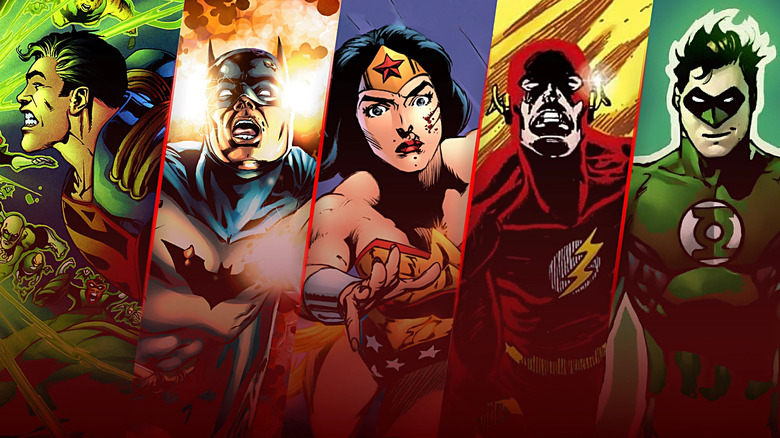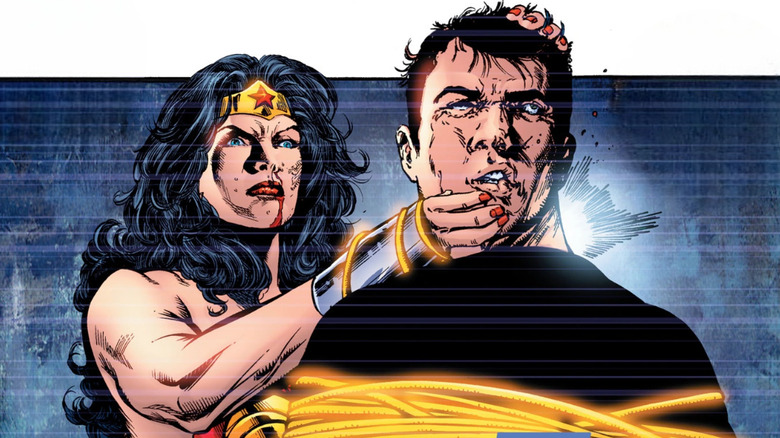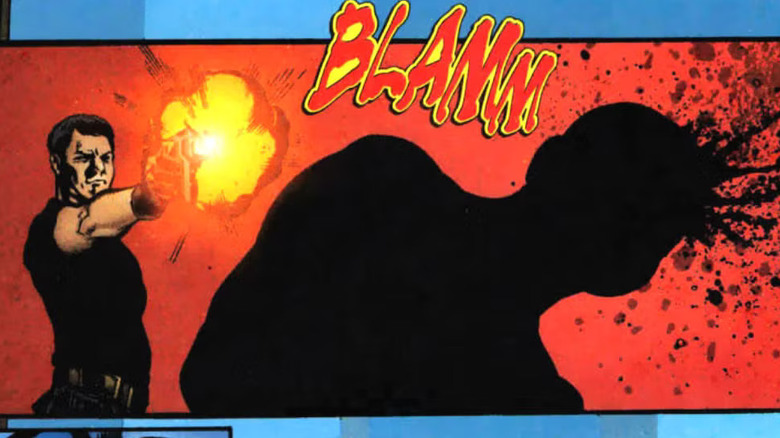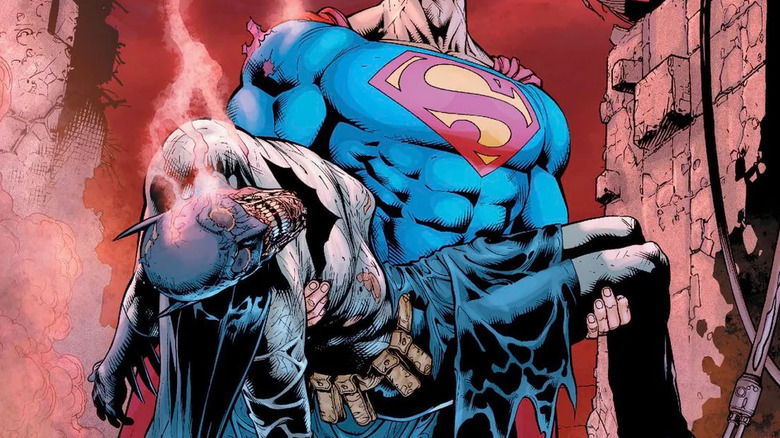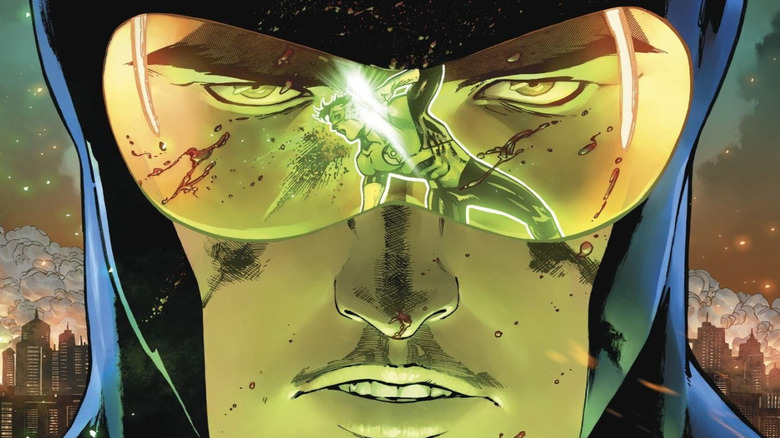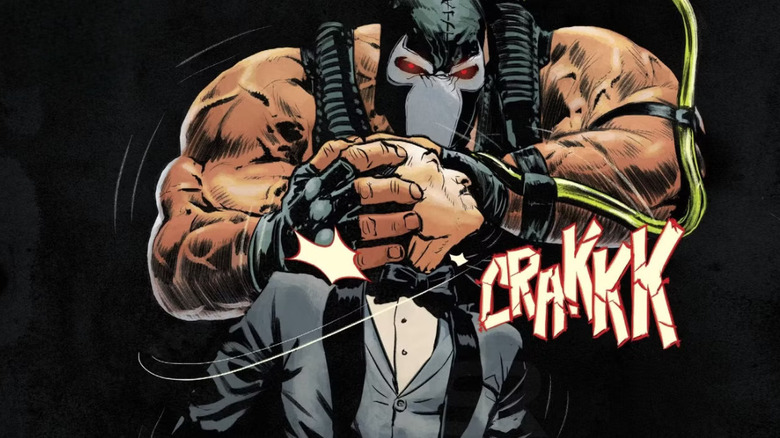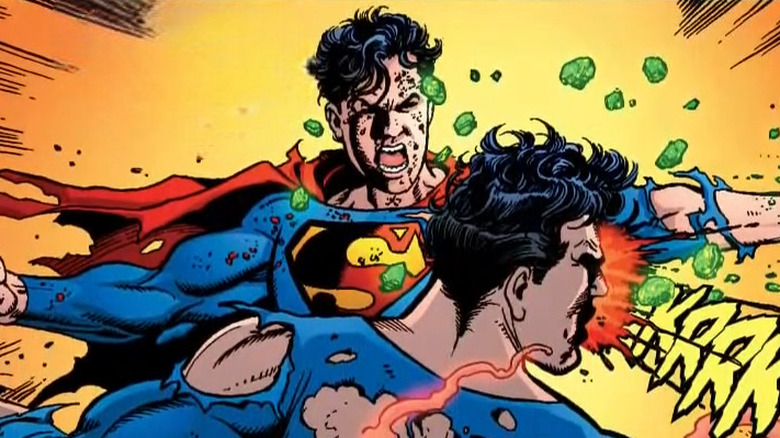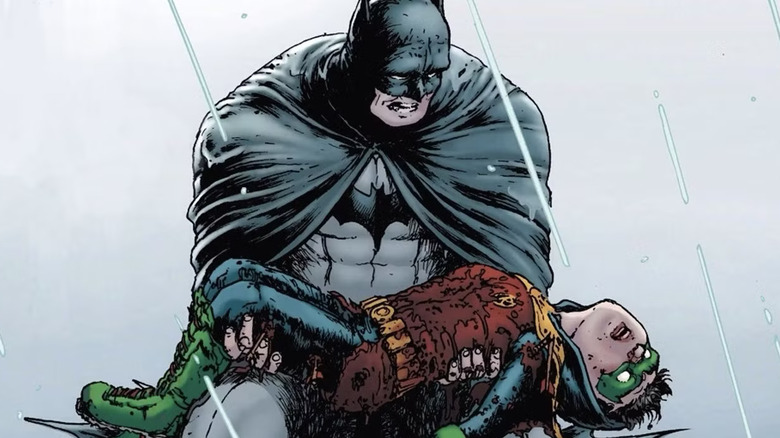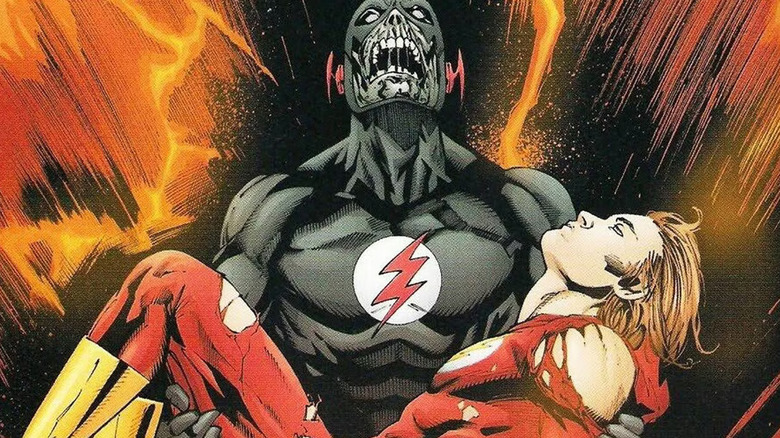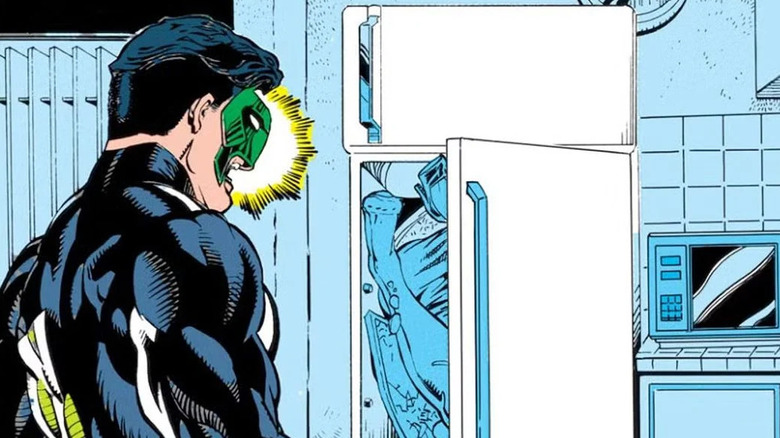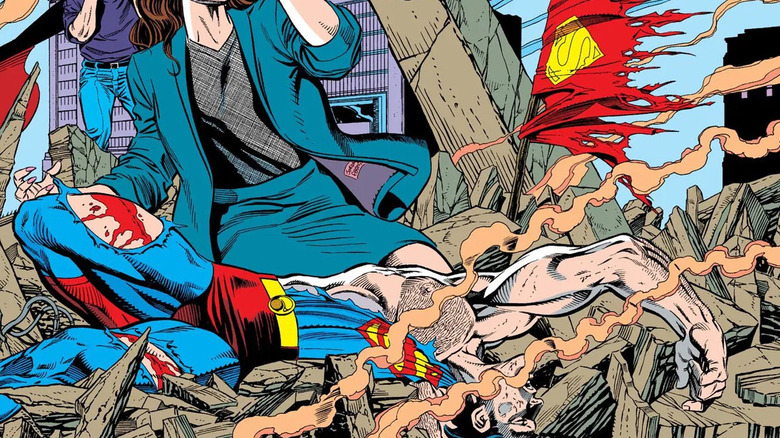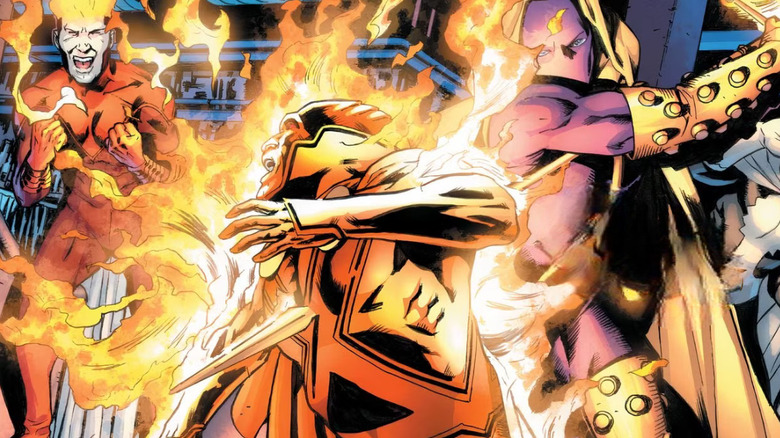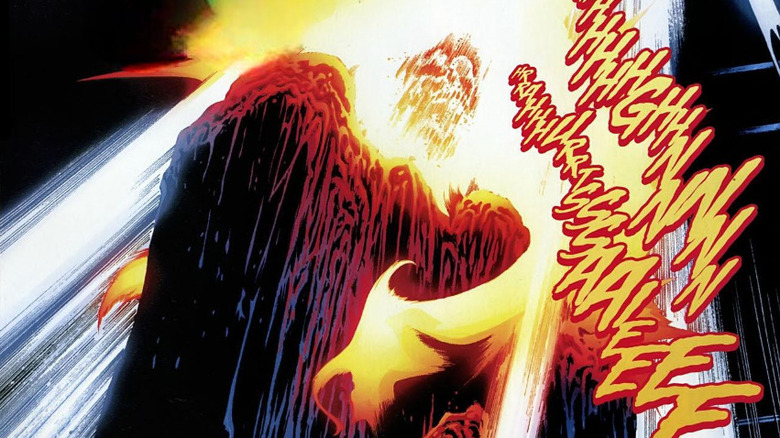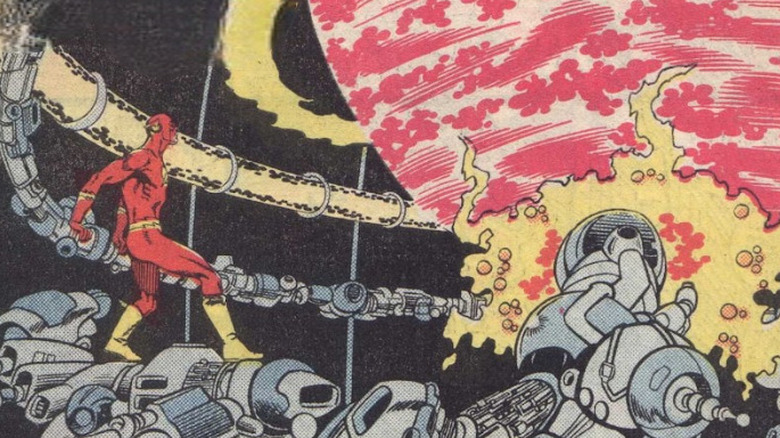15 Most Brutal Deaths In DC Comics, Ranked
With most of them having PG-13 ratings and aisles of toys marketed to young children, films like James Gunn's "Superman" have helped fuel the popular — and perhaps true — perception that DC Comics are primarily meant to entertain and inspire younger audiences. Maybe these bright, colorful characters are best used in stories that all ages can enjoy, as their source material was for decades — at least, until the censors backed off and comics started to get really dark.
Especially if you read a major event from the post-"Crisis on Infinite Earths" era, you'll discover a darker DC Universe than you might recognize from popular media — not even the films of Zack Snyder can compare to the political angst of "The Dark Knight Returns" or "Watchmen," the aggressive violence of "A Death in the Family," "The Killing Joke," and "The Death of Superman," or the wanton slaughter of each subsequent "Crisis" storyline. Largely from this era — with a few more recent entries that might shock you — we discovered the depths of brutality within the DC Universe.
15. Wonder Woman bound and killed Maxwell Lord
Back in 2005, DC was gearing up for "Infinite Crisis," a company-wide mega-event slated to refine the DC multiverse in bloody fashion. Suffice it to say, it was strenuously angsty and written around interrogating (and exploiting) the darker tone contemporary comic books had taken in the post-"Crisis on Infinite Earths" DCU.
This ironically led to what many consider to have been the character assassination of Wonder Woman, who was an easy target for DC writers and editors eager for a marquee superhero to break bad before the big event. In "Wonder Woman" #219 by Greg Rucka and Rags Morales, the Princess of the Amazons captures former Justice League International financier Maxwell Lord after he manages to exert total telepathic control over Superman.
When she ensnares him in her lasso of truth, Lord admits that he has every intention of using Superman to sow chaos, destruction, and death for as long as he breathes — so, naturally, Wonder Woman twists his neck 180 degrees, killing him instantly. Though tame compared to many of the other deaths on this list, the act resulted in both Batman and Superman ostracizing Wonder Woman for much of "Infinite Crisis."
14. Blue Beetle was executed by Maxwell Lord
In the one-shot lead-in "Countdown to Infinite Crisis," Ted Kord (the second Blue Beetle) discovers that someone has amassed a secret database of Justice League private information — including the secret identities of members. Despite going to Batman, Superman, Wonder Woman, and several other leaguers for help, everyone essentially dismisses him as paranoid (again, it seems as though "Infinite Crisis" was a story motivated by plot rather than character).
Ted follows his investigation to the secret lair of — surprise, surprise — Maxwell Lord, who reveals he's been a double agent all along, working undercover as the leader of the Amanda Waller-backed intelligence agency Checkmate. Lord had managed to secure much of that Justice League info by hacking into Brother Eye, an AI surveillance satellite designed by none other than Batman. With his ultimate goal being the benevolent extermination of all metahumans for some hand-wavy greater good, Lord invites Ted to join him — and when Ted refuses, he's killed with a graphic gunshot to the head. Part of Wonder Woman's decision to kill Lord herself comes from the realization that he murdered Ted and had secretly betrayed them. It's worth noting that, with "Superman" introducing both Lord and his "Justice Gang," it isn't hard to imagine his DC Universe heading into a similar storyline in the near-ish future.
13. Sue Dibny was murdered and set on fire
Stepping away from "Infinite Crisis" for the time being, we now turn toward one of the comics that represents a peak in the oppressively grim tone DC adopted in the '90s and 2000s — the 2004-2005 miniseries "Identity Crisis." The story by Brad Meltzer and Rags Morales begins with the discovery of Sue Dibny's body. Sue, a civilian, was the longtime wife of Justice League member Ralph Dibny (aka the Elongated Man), and had been close with many other members of the team and their spouses.
Given that her remains were disturbingly charred, the League quickly narrows their suspect list down to Doctor Light, a supervillain with the power to generate bright, hot energy who is revealed in the series to have assaulted Sue at the Justice League Watchtower sometime in the recent past. As the team rallies to track him down, they all take greater precautions to protect their loved ones — which, as it turns out, was the killer's objective all along.
In actuality, Sue was not murdered by the otherwise vile Doctor Light, but rather former fellow civilian spouse, Jean Loring. She had used her ex-husband Ray Palmer's Atom technology to merely injure Sue (hoping it would compel him to return as her protector), but she accidentally murdered her by entering her brain. She burned the corpse afterwards to throw off suspicion, and much of "Identity Crisis" unfolded as a result of her attempts to conceal her guilt.
12. Batman was fried by Darkseid
"Crisis" this, "Crisis" that, we know, we know. These events are in large part defined (and marketed) by their willingness to kill major heroes in dramatic fashion — and there are few if any heroes more surprising to see killed than the Dark Knight himself.
From Grant Morrison, J.G. Jones, and Marco Rudy, the 2008 mega-event "Final Crisis" (which was not, in fact, the final crisis) is a dark, apocalyptic epic that sees Darkseid successfully obtain and disseminate the Anti-Life Equation. Many heroes are corrupted during the war that he wages against the forces of Earth, which he knows will end with his own victory and subsequent demise.
Batman is one of the few heroes to have avoided subjugation and, using a bullet made of Radion (a supernatural substance toxic to the New Gods) which he recovered from the murder of Darkseid's son, Orion, is able to wound the despotic ruler of Apokolips. At the same time Batman fired his weapon, however, Darkseid fired the ocular Omega Sanction, which strikes its target, turning Batman into a lifeless skeleton. Though it's eventually revealed that the beams sent Bruce Wayne back to the dawn of humanity, this temporary "death" is still as brutal as they come.
11. The Green Lantern killed himself with his ring
We've tried to restrain ourselves against including too many alternate universe deaths on this list — otherwise, we could fill it up entirely with moments from DC and NetherRealm's "Injustice" universe. However, the death of Green Lantern Hal Jordan — technically within a divergent timeline of the mainstream DC Universe (so it mostly still counts!) — is so disturbing that we had to find a place for it.
In the lead-up to the ill-fated marriage of Bruce Wayne and Selina Kyle during Tom King and Tony S. Daniel's run on "Batman," Booster Gold tries to give his old pal the perfect wedding gift — Thomas and Martha Wayne. He uses his time travel abilities to prevent their deaths, which results in the present timeline being obscenely corrupted. Hal Jordan is one of countless people driven insane by a strain of Joker toxin, ultimately inspiring him to override his ring's will with his own just so that he can blast his own skull with energy. Y'know, to show how "TwIsTeD" he is, or something. (Definitely not our favorite King storyline.)
10. Alfred Pennyworth was broken by Bane
Speaking of Tom King's "Batman," when he was partnered with artist Mikel Janin for the subsequent "City of Bane" storyline, the pair seemed to take pleasure in the further torment of their protagonist — going so far as to have his biological father indirectly kill his surrogate father. To make a long, convoluted story extremely short, the "Flashpoint" Batman (Thomas Wayne, from a reality where Bruce died in the alley) worked with the main universe Bane to psychologically torture Bruce so he would give up his life of crimefighting, even manipulating Selina Kyle / Catwoman into breaking off their engagement.
Thomas is successful in forcing Bruce into exile and delivering Gotham City to Bane, but keeps Alfred Pennyworth as a hostage to ensure the lesson sticks. Unfortunately, Damian Wayne attempts to rescue his butler and closest friend and is caught — after which Thomas forces Damian to watch as Bane snaps Alfred's neck.
9. Superboy-Prime beat Superman to death
What better way is there to prove yourself as the strongest Kryptonian of all time than by killing the original Superman? After "Crisis on Infinite Earths" turned Superboy-Prime and Alexander Luthor (the Lex Luthor of the morally inverted Earth-3) into multiversal refugees, they teamed up to rewrite reality according to their own desires — leading to the events of "Infinite Crisis."
Superboy's quest to be a hero once more ironically sees him reduced to a homicidal maniac, unrecognizable to the Golden Age Superman he fought with during the original "Crisis" event. Though the latter teams up with the contemporary mainstream Superman to take Superboy-Prime down, it comes at great cost. All three of them have their powers diminished by a red sun — soon after, Superboy-Prime tackles the Golden Age Superman and unleashes all his anger, turning the face of his former mentor into a bloody pulp.
8. Damian Wayne got skewered
Everyone remembers the death of Batman's second Robin — but what about the time his own son was killed in battle? During Grant Morrison's "Batman Incorporated," Damian Wayne is shown to have incurred the wrath of his mother, Talia al Ghul, by joining Batman's crusade against crime and refusing to return home. She decides to place a bounty on his head, a situation which Bruce initially manages to defuse by faking Damian's death until he and the Bat Family can take her down.
Sadly, the littlest Robin returns to the front lines during a climactic showdown at Wayne Tower, where he is swiftly skewered by the sword of the Heretic, an unfeeling warrior cloned from Damian's very own DNA. This death was very real but also very temporary — about a year after his death was published (and after getting his corpse stolen and recovered way too many times), Damian is resurrected by Apokoliptic science magic.
7. The Rogues de-powered the Flash -- then beat him to death
Just before the return of Barry Allen — a hero who suffered his own brutal demise in the '80s — his longtime enemies the Rogues achieved a solid speedster double kill, breaking their usual oath of non-lethal violence. Their first victim was Bart Allen, the fourth Flash as well as Barry's time-displaced grandson from a future timeline, who was essentially served to them on a silver platter by his arch-nemesis Inertia (aka Thaddeus Thawne).
Inertia spends the last issues of "The Flash: The Fastest Man Alive" trying to rob Bart of his speed in order to regain powers he had lost. Once he manages to depower Bart in front of the Rogues, the villains seize the opportunity to vanquish their foe by beating him to death. Not long after, during "Final Crisis," the Rogues would even the score (and get vengeance for Weather Wizard's murdered baby) by joining forces to kill Thawne.
6. Kyle Rayner's girlfriend was infamously fridged
This entry is quietly one of the more influential deaths on our list — though perhaps not in the way you'd expect. In "Green Lantern" #54 from 1994, the titular guardian (then the artist Kyle Rayner) discovers that his longtime girlfriend and brief partner in crimefighting Alexandra DeWitt has been strangled to death by the insultingly forgettable villain Major Force. When Kyle discovers her body, it's been shoved into a fridge, seemingly just to elevate the shock and horror of it all from a narrative perspective.
A few years after the comic was published, prolific comic book writer Gail Simone criticized the death of Alexandra as representative of how female supporting characters in fiction (superhero stories in particular) are brutally murdered solely in service of progressing a male character's storyline. She coined the term "fridging" to refer to this phenomenon, which has since been embraced by entertainment criticism at large, recognizable even to those who may not know its origins.
5. The Joker beat Jason Todd to death with a crowbar
There may be deaths on this list more brutal than this one, but it's undoubtedly a sore spot for many comic book fans — especially if they themselves were one of the culprits. In Jim Starlin and Jim Aparo's "A Death in the Family," the Joker kidnaps Jason Todd, uses a crowbar to beat him within an inch of his life, then leaves him to be blown up by an explosive. Heartbreakingly, Jason's last act is an attempt to save his long-lost biological mother who, having been captured by the Joker as well, ultimately dies in the explosion.
Jason's fate (though not the exact nature of it) was determined democratically, via a voting process that invited readers to call one of two numbers depending on whether or not they wanted Jason to survive the story. In continuity, it remains one of the cruelest things the Joker has ever done to the Bat Family.
4. Doomsday violently brought about the Death of Superman
As made even more famous by Zack Snyder's "Batman v Superman: Dawn of Justice" (and having been adapted even more recently by the TV series "Superman and Lois"), "The Death of Superman" is one of the most consequential stories about the Man of Steel ever written. In the crossover event, Earth is terrorized by Doomsday, an unbelievably strong "Superman" villain of Kryptonian origin who nearly overpowers the hero.
Capable of constantly evolving himself to survive any threat and surpass any foe, Superman is only able to slay him in a pyrrhic victory. Physically broken after an epic battle, Kal-El dies surrounded by friends in the ruins of Metropolis. It isn't a death that's remembered for being particularly brutal, but there's no denying how monstrous it is for an indestructible man to be clobbered to death throughout the city he protects. The only reason it isn't significantly higher on this list is that, expectedly, he was revived fairly quickly after the event.
3. Martian Manhunter was burned alive
Martian Manhunter may not be the most popular DC character compared to those that have been overrepresented on the big screen, but it was still a devastating narrative blow when he was killed toward the beginning of "Final Crisis." As Darkseid was preparing to return to Earth as its conqueror, he tasked the supervillain Libra with assembling a Secret Society of Supervillains to serve him.
Libra is a deceptively dangerous villain, capable of limited power absorption and mind control. He is able to easily subjugate the weaker-minded bad guys, but struggles with the likes of Lex Luthor, Gorilla Grodd, and Ocean Master. Thus, to prove that allegiance to the Society and Darkseid will indeed grant them the domination they crave, he grants the Human Flame his deepest desire — the corpse of the Martian Manhunter. Once Libra drags J'onn J'onzz before them, piercing his chest with a spear that sets his body ablaze, the villains of Earth embrace his leadership.
2. Doctor Light was melted alive by the Spectre
It was hard for us not to put Doctor Light's much-deserved demise during "Final Crisis" at the very top of this list, if only for the sheer inhumanity of the entire sequence. The only thing holding it back is how depressingly empty it feels.
Arthur Light is one of the many villains recruited by Libra during Darkseid's war, a party to the slaying of Martian Manhunter. To celebrate, Light hires three sex workers, holds them captive, and forces them to dress up as members of the Teen Titans so he can act out violent fantasies. It's way too much for a superhero comic, and borders on irresponsible and unnecessary.
It does, however, serve to remind readers how awful Light is, so they can take some cathartic pleasure in watching the Spectre melt him alive. As the vengeful spirit watches Light cry out in agony, he remarks that he himself feels nothing — and we kinda have to agree with him there.
If you or anyone you know has been a victim of sexual assault, help is available. Visit the Rape, Abuse & Incest National Network website or contact RAINN's National Helpline at 1-800-656-HOPE (4673).
1. The Flash ran himself to death
The death of Barry Allen remains a haunting and pivotal moment in DC Comics history. And, of course, fittingly and perhaps predictably at this point, it took place as one of the climaxes of the first "Crisis" event of them all — 1985's "Crisis on Infinite Earths."
More a masterwork of using narrative to explain custodial world-managing than a truly great story in its own right, Barry's sacrifice in Issue #8 (by event architects Marv Wolfman and George Pérez) stands out as a genuine dramatic achievement. As the Anti-Monitor nears the completion of anti-matter cannon, the last hope for all reality is Barry's ability to destroy the machine's power core by doing what he does best — running around a thing really fast.
Tragically, Barry runs so fast that he starts to run backward in time as the energy of the power core rips through him. He sees the flashing faces of Wally West and Batman, confused by his momentary presence as he screams in vain for anyone to save him — his flesh melting around his bones all the while. By the end of his run, his body has completely disintegrated. Heroic sacrifices are a dime a dozen, but it's the combination of the stakes of Barry's sacrifice specifically, his haunting pleas for help, and the fact that he wouldn't return from the dead for over 20 real years that makes this the most brutal death in the DC Universe.
